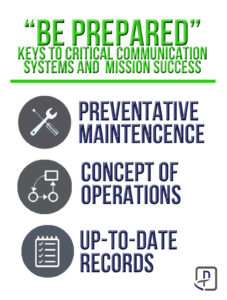
“Be Prepared!” It serves as the Boy Scout motto and should also serve as the motto for your team’s preparedness.

We never know when an event is going to occur that will require Critical Communication Services. Floods, tornadoes, fires and large scale, multi-agency coordinated events are occurring far too frequently these days. Just one day ago, several coordinated terrorist attacks occurred in New York City and New Jersey, injuring 29 people. Multiple agencies, including the NYPD and federal agencies, responded to the bombings and provided mutual aid. At a time like that, what happens if those agencies were not prepared to communicate affectively?A well prepared Communications Officer will make sure that their equipment is in fully operational status at all times. Whether your critical communications relies on LMR, 4G LTE or VSAT, you need to trust that your equipment is ready to go in a moment’s notice. Disciplined maintenance, knowledge of the system set-up and up-to-date records are the basis for avoiding unexpected failures.
Preventative Maintenance Plan
A key element is a preventative maintenance plan. Do you set up and exercise your Critical Communications equipment quarterly, monthly or even weekly? Preventative maintenance can take as little as an hour to perform and will save you from almost 75% of in-the-field failures.Here are a few important tips for surveying and maintaining communications equipment:
- Conduct a visual inspection of the equipment; often times signs of fatigue or pending failure can be seen with a quick eye test.
- Take a few minutes to inspect all the seals and gaskets. Service the equipment in accordance with the original manufacturers suggestions. Motors and free moving parts on VSAT (satellite) antennas should be free of dirt and other debris that can cause expensive repairs down the road.
- Check and tighten any loose hardware.
- Critical system components should have spares readily available, just in case.
These simple steps can help prevent inconvenient service outages.
Concept of Operations
“Be Prepared” when it comes time to deploy. Is the system set up clearly defined and easy to follow? Having a solid Concept of Operations (CONOPS) guideline is key to mission success. A well-defined document will enable a user with limited experience to ensure mission operations are smooth and effective. CONOPS are widely used in the military, but should be applied to all communication systems regardless of industry or level.CONOPS and system drawings should be up to date to illustrate how equipment connects and interoperates.
Records and Documentation
Maintenance and configuration changes should be documented in a site log. Even the most basic of changes to the system should be recorded and kept local with the communications suite. Time spent troubleshooting issues can be dramatically reduced if all records are up to date and accurate. Entries into the log should be made during each inspection so a complete record of the entire system and its condition is available.Taking the time to “Be Prepared” is far less expensive than repairing preventable failures and will ensure mission success.Written by Chris Eakins, Communication Services
Stay Up To Date
Keep up with PEAKE and everything we’re doing.
